
A | B | C | D | E | F | G | H | CH | I | J | K | L | M | N | O | P | Q | R | S | T | U | V | W | X | Y | Z | 0 | 1 | 2 | 3 | 4 | 5 | 6 | 7 | 8 | 9
Swiss Confederation | |
|---|---|
| Motto: (unofficial) "Unus pro omnibus, omnes pro uno" "One for all, all for one" | |
| Anthem: "Swiss Psalm" | |
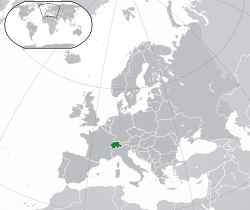 Location of Switzerland (green) in Europe (green and dark grey) | |
| Capital | 46°57′N 7°27′E / 46.950°N 7.450°E |
| Largest city | Zürich |
| Official languages |
|
| Religion |
|
| Demonym(s) | |
| Government | Federal assembly-independent[4][5] directorial republic |
| Viktor Rossi | |
| Legislature | Federal Assembly |
| Council of States | |
| National Council | |
| History | |
• Founded | 1 August 1291[c] |
• Sovereignty recognised (Peace of Westphalia) | 24 October 1648 |
| 7 August 1815 | |
| 12 September 1848[d][6] | |
| Area | |
• Total | 41,285 km2 (15,940 sq mi) (132nd) |
• Water (%) | 4.34[7] |
| Population | |
• 2023 estimate | 8,902,308[8] (99th) |
• 2015 census | |
• Density | 207/km2 (536.1/sq mi) (48th) |
| GDP (PPP) | 2024 estimate |
• Total | |
• Per capita | |
| GDP (nominal) | 2024 estimate |
• Total | |
• Per capita | |
| Gini (2022) | medium |
| HDI (2022) | very high (1st) |
| Currency | Swiss franc (CHF) |
| Time zone | UTC+1 (CET) |
• Summer (DST) | UTC+2 (CEST) |
| Date format | dd.mm.yyyy (Anno Domini) |
| Driving side | right |
| Calling code | +41 |
| ISO 3166 code | CH |
| Internet TLD | .ch, .swiss |
Switzerland, officially the Swiss Confederation, is a landlocked country located in west-central Europe.[e][13] It is bordered by Italy to the south, France to the west, Germany to the north and Austria and Liechtenstein to the east. Switzerland is geographically divided among the Swiss Plateau, the Alps and the Jura; the Alps occupy the greater part of the territory, whereas most of the country's population of 9 million are concentrated on the plateau, which hosts its largest cities and economic centres, including Zürich, Geneva and Basel.[14]
Switzerland originates from the Old Swiss Confederacy established in the Late Middle Ages, following a series of military successes against Austria and Burgundy; the Federal Charter of 1291 is considered the country's founding document. Swiss independence from the Holy Roman Empire was formally recognised in the Peace of Westphalia in 1648. Switzerland has maintained a policy of armed neutrality since the 16th century and has not fought an international war since 1815. It joined the United Nations only in 2002 but pursues an active foreign policy that includes frequent involvement in peace building.[15]
Switzerland is the birthplace of the Red Cross and hosts the headquarters or offices of most major international institutions, including the WTO, the WHO, the ILO, FIFA, and the UN. It is a founding member of the European Free Trade Association (EFTA), but not part of the European Union (EU), the European Economic Area, or the eurozone; however, it participates in the European single market and the Schengen Area. Switzerland is a federal republic composed of 26 cantons, with federal authorities based in Bern.[a][2][1]
Switzerland is one of the world's most developed countries, with the highest nominal wealth per adult[16] and the eighth-highest gross domestic product (GDP) per capita.[17][18] Switzerland ranks first in the Human Development Index since 2021 and performs highly also on several international metrics, including economic competitiveness and democratic governance. Cities such as Zürich, Geneva and Basel rank among the highest in terms of quality of life,[19][20] albeit with some of the highest costs of living.[21]
It has four main linguistic and cultural regions: German, French, Italian and Romansh. Although most Swiss are German-speaking, national identity is fairly cohesive, being rooted in a common historical background, shared values such as federalism and direct democracy,[22][page needed] and Alpine symbolism.[23][24] Swiss identity transcends language, ethnicity, and religion, leading to Switzerland being described as a Willensnation ("nation of volition") rather than a nation state.[25] Due to its linguistic diversity, Switzerland is known by multiple native names: Schweiz [ˈʃvaɪts][f] (German);[g] Suisse [sɥis(ə)] ⓘ (French); Svizzera [ˈzvittsera] (Italian); and Svizra [ˈʒviːtsrɐ, ˈʒviːtsʁɐ][h] (Romansh). On coins and stamps, the Latin name, Confoederatio Helvetica—frequently shortened to "Helvetia"—is used instead of the spoken languages.
Etymology
The English name Switzerland is a portmanteau of Switzer, an obsolete term for a Swiss person which was in use during the 16th to 19th centuries, and land.[26] The English adjective Swiss is a loanword from French Suisse, also in use since the 16th century. The name Switzer is from the Alemannic Schwiizer, in origin an inhabitant of Schwyz and its associated territory, one of the Waldstätte cantons which formed the nucleus of the Old Swiss Confederacy. The Swiss began to adopt the name for themselves after the Swabian War of 1499, used alongside the term for "Confederates", Eidgenossen (literally: comrades by oath), used since the 14th century. The data code for Switzerland, CH, is derived from Latin Confoederatio Helvetica (Helvetic Confederation).
The toponym Schwyz itself was first attested in 972, as Old High German Suittes, perhaps related to swedan 'to burn' (cf. Old Norse svíða 'to singe, burn'), referring to the area of forest that was burned and cleared to build.[27] The name was extended to the area dominated by the canton, and after the Swabian War of 1499 gradually came to be used for the entire Confederation.[28][29] The Swiss German name of the country, Schwiiz, is homophonous to that of the canton and the settlement, but distinguished by the use of the definite article (d'Schwiiz for the Confederation,[30] but simply Schwyz for the canton and the town).[31] The long of Swiss German is historically and still often today spelled ⟨y⟩ rather than ⟨ii⟩, preserving the original identity of the two names even in writing.
The Latin name Confoederatio Helvetica was neologised and introduced gradually after the formation of the federal state in 1848, harking back to the Napoleonic Helvetic Republic. It appeared on coins from 1879, inscribed on the Federal Palace in 1902 and after 1948 used in the official seal[32] (e.g., the ISO banking code "CHF" for the Swiss franc, and the country top-level domain ".ch", are both taken from the state's Latin name). Helvetica is derived from the Helvetii, a Gaulish tribe living on the Swiss Plateau before the Roman era.
Helvetia appeared as a national personification of the Swiss confederacy in the 17th century in a 1672 play by Johann Caspar Weissenbach.[33]
History
The state of Switzerland took its present form with the adoption of the Swiss Federal Constitution in 1848. Switzerland's precursors established a defensive alliance in 1291, forming a loose confederation that persisted for centuries.
Beginnings
The oldest traces of hominid existence in Switzerland date to about 150,000 years ago.[34] The oldest known farming settlements in Switzerland, which were found at Gächlingen, date to around 5300 BC.[34]
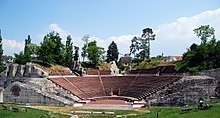
The earliest known tribes formed the Hallstatt and La Tène cultures, named after the archaeological site of La Tène on the north side of Lake Neuchâtel. La Tène culture developed and flourished during the late Iron Age from around 450 BC,[34] possibly influenced by Greek and Etruscan civilisations. One of the most important tribal groups was the Helvetii. Steadily harassed by Germanic tribes, in 58 BC, the Helvetii decided to abandon the Swiss Plateau and migrate to western Gallia. Julius Caesar's armies pursued and defeated them at the Battle of Bibracte, in today's eastern France, forcing the tribe to move back to its homeland.[34] In 15 BC, Tiberius (later the second Roman emperor) and his brother Drusus conquered the Alps, integrating them into the Roman Empire. The area occupied by the Helvetii first became part of Rome's Gallia Belgica province and then of its Germania Superior province. The eastern portion of modern Switzerland was integrated into the Roman province of Raetia. Sometime around the start of the Common Era, the Romans maintained a large camp called Vindonissa, now a ruin at the confluence of the Aare and Reuss rivers, near the town of Windisch.[36]
The first and second century AD was an age of prosperity on the Swiss Plateau. Towns such as Aventicum, Iulia Equestris and Augusta Raurica, reached a remarkable size, while hundreds of agricultural estates (Villae rusticae) were established in the countryside.[citation needed]
Around 260 AD, the fall of the Agri Decumates territory north of the Rhine transformed today's Switzerland into a frontier land of the Empire. Repeated raids by the Alamanni tribes provoked the ruin of the Roman towns and economy, forcing the population to shelter near Roman fortresses, like the Castrum Rauracense near Augusta Raurica. The Empire built another line of defence at the north border (the so-called Donau-Iller-Rhine-Limes). At the end of the fourth century, the increased Germanic pressure forced the Romans to abandon the linear defence concept. The Swiss Plateau was finally open to Germanic tribes.[citation needed]
In the Early Middle Ages, from the end of the fourth century, the western extent of modern-day Switzerland was part of the territory of the Kings of the Burgundians. The Alemanni settled the Swiss Plateau in the fifth century and the valleys of the Alps in the eighth century, forming Alemannia. Modern-day Switzerland was then divided between the kingdoms of Alemannia and Burgundy.[34] The entire region became part of the expanding Frankish Empire in the sixth century, following Clovis I's victory over the Alemanni at Tolbiac in 504 AD, and later Frankish domination of the Burgundians.[37][38]
Throughout the rest of the sixth, seventh and eighth centuries, Swiss regions continued under Frankish hegemony (Merovingian and Carolingian dynasties) but after its extension under Charlemagne, the Frankish Empire was divided by the Treaty of Verdun in 843.[34] The territories of present-day Switzerland became divided into Middle Francia and East Francia until they were reunified under the Holy Roman Empire around 1000 AD.[34]
By 1200, the Swiss Plateau comprised the dominions of the houses of Savoy, Zähringer, Habsburg, and Kyburg.[34] Some regions (Uri, Schwyz, Unterwalden, later known as Waldstätten) were accorded the Imperial immediacy to grant the empire direct control over the mountain passes. With the extinction of its male line in 1263, the Kyburg dynasty fell in AD 1264. The Habsburgs under King Rudolph I (Holy Roman Emperor in 1273) laid claim to the Kyburg lands and annexed them, extending their territory to the eastern Swiss Plateau.[37]
Old Swiss Confederacy
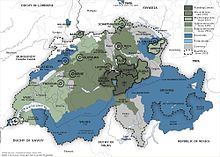

The Old Swiss Confederacy was an alliance among the valley communities of the central Alps. The Confederacy was governed by nobles and patricians of various cantons who facilitated management of common interests and ensured peace on mountain trade routes. The Federal Charter of 1291 is considered the confederacy's founding document, even though similar alliances likely existed decades earlier. The document was agreed among the rural communes of Uri, Schwyz, and Unterwalden.[39][page needed][40]
By 1353, the three original cantons had joined with the cantons of Glarus and Zug and the Lucerne, Zürich and Bern city-states to form the "Old Confederacy" of eight states that obtained through the end of the 15th century.[40] The expansion led to increased power and wealth for the confederation. By 1460, the confederates controlled most of the territory south and west of the Rhine to the Alps and the Jura mountains, and the University of Basel was founded (with a faculty of medicine) establishing a tradition of chemical and medical research. This increased after victories against the Habsburgs (Battle of Sempach, Battle of Näfels), over Charles the Bold of Burgundy during the 1470s, and the success of the Swiss mercenaries. The Swiss victory in the Swabian War against the Swabian League of Emperor Maximilian I in 1499 amounted to de facto independence within the Holy Roman Empire.[40] In 1501, Basel[41] and Schaffhausen joined the Old Swiss Confederacy.[42]
The Confederacy acquired a reputation of invincibility during these earlier wars, but expansion of the confederation suffered a setback in 1515 with the Swiss defeat in the Battle of Marignano. This ended the so-called "heroic" epoch of Swiss history.[40] The success of Zwingli's Reformation in some cantons led to inter-cantonal religious conflicts in 1529 and 1531 (Wars of Kappel). It was not until more than one hundred years after these internal wars that, in 1648, under the Peace of Westphalia, European countries recognised Switzerland's independence from the Holy Roman Empire and its neutrality.[37][38]
During the Early Modern period of Swiss history, the growing authoritarianism of the patriciate families combined with a financial crisis in the wake of the Thirty Years' War led to the Swiss peasant war of 1653. In the background to this struggle, the conflict between Catholic and Protestant cantons persisted, erupting in further violence at the First War of Villmergen, in 1656, and the Toggenburg War (or Second War of Villmergen), in 1712.[40]
Napoleonic era
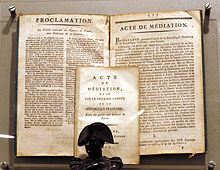
In 1798, the revolutionary French government invaded Switzerland and imposed a new unified constitution.[40] This centralised the government of the country, effectively abolishing the cantons: moreover, Mülhausen left Switzerland and the Valtellina valley became part of the Cisalpine Republic. The new regime, known as the Helvetic Republic, was highly unpopular. An invading foreign army had imposed and destroyed centuries of tradition, making Switzerland nothing more than a French satellite state. The fierce French suppression of the Nidwalden Revolt in September 1798 was an example of the oppressive presence of the French Army and the local population's resistance to the occupation.[citation needed]
When war broke out between France and its rivals, Russian and Austrian forces invaded Switzerland. The Swiss refused to fight alongside the French in the name of the Helvetic Republic. In 1803 Napoleon organised a meeting of the leading Swiss politicians from both sides in Paris. The Act of Mediation was the result, which largely restored Swiss autonomy and introduced a Confederation of 19 cantons.[40] Henceforth, much of Swiss politics would concern balancing the cantons' tradition of self-rule with the need for a central government.[citation needed]
In 1815 the Congress of Vienna fully re-established Swiss independence, and the European powers recognised permanent Swiss neutrality.[37][38][40] Swiss troops served foreign governments until 1860 when they fought in the siege of Gaeta. The treaty allowed Switzerland to increase its territory, with the admission of the cantons of Valais, Neuchâtel and Geneva. Switzerland's borders saw only minor adjustments thereafter.[43]
Federal state
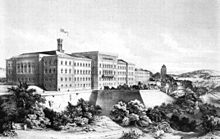
The restoration of power to the patriciate was only temporary. After a period of unrest with repeated violent clashes, such as the Züriputsch of 1839, civil war (the Sonderbundskrieg) broke out in 1847 when some Catholic cantons tried to set up a separate alliance (the Sonderbund).[40] The war lasted less than a month, causing fewer than 100 casualties, most of which were through friendly fire. The Sonderbundskrieg had a significant impact on the psychology and society of Switzerland.[citation needed][who?]
The war convinced most Swiss of the need for unity and strength. Swiss from all strata of society, whether Catholic or Protestant, from the liberal or conservative current, realised that the cantons would profit more from merging their economic and religious interests.[citation needed]
Thus, while the rest of Europe saw revolutionary uprisings, the Swiss drew up a constitution that provided for a federal layout, much of it inspired by the American example. This constitution provided central authority while leaving the cantons the right to self-government on local issues. Giving credit to those who favoured the power of the cantons (the Sonderbund Kantone), the national assembly was divided between an upper house (the Council of States, two representatives per canton) and a lower house (the National Council, with representatives elected from across the country). Referendums were made mandatory for any amendments.[38] This new constitution ended the legal power of nobility in Switzerland.[44]

A single system of weights and measures was introduced, and in 1850 the Swiss franc became the Swiss single currency, complemented by the WIR franc in 1934.[45] Article 11 of the constitution forbade sending troops to serve abroad, marking the end of foreign service. It came with the expectation of serving the Holy See, and the Swiss were still obliged to serve Francis II of the Two Sicilies with Swiss Guards present at the siege of Gaeta in 1860.[citation needed]
An important clause of the constitution was that it could be entirely rewritten, if necessary, thus enabling it to evolve as a whole rather than being modified one amendment at a time.[46][page needed]
This need soon proved itself when the rise in population and the Industrial Revolution that followed led to calls to modify the constitution accordingly. The population rejected an early draft in 1872, but modifications led to its acceptance in 1874.[40] It introduced the facultative referendum for laws at the federal level. It also established federal responsibility for defence, trade, and legal matters.
In 1891, the constitution was revised with uncommonly strong elements of direct democracy, which remain unique today.[40]
Modern history
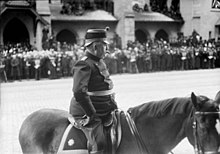
Switzerland was not invaded during either of the world wars. During World War I, Switzerland was home to the revolutionary and founder of the Soviet Union Vladimir Illych Ulyanov (Vladimir Lenin) who remained there until 1917.[47] Swiss neutrality was seriously questioned by the short-lived Grimm–Hoffmann affair in 1917. In 1920, Switzerland joined the League of Nations, which was based in Geneva, after it was exempted from military requirements.[48]
During World War II, detailed invasion plans were drawn up by the Germans,[49] but Switzerland was never attacked.[50] Switzerland was able to remain independent through a combination of military deterrence, concessions to Germany, and good fortune, as larger events during the war intervened.[38][51] General Henri Guisan, appointed the commander-in-chief for the duration of the war ordered a general mobilisation of the armed forces. The Swiss military strategy changed from static defence at the borders to organised long-term attrition and withdrawal to strong, well-stockpiled positions high in the Alps, known as the Reduit. Switzerland was an important base for espionage by both sides and often mediated communications between the Axis and Allied powers.[51]
Switzerland's trade was blockaded by both the Allies and the Axis. Economic cooperation and extension of credit to Nazi Germany varied according to the perceived likelihood of invasion and the availability of other trading partners. Concessions reached a peak after a crucial rail link through Vichy France was severed in 1942, leaving Switzerland (together with Liechtenstein) entirely isolated from the wider world by Axis-controlled territory. Over the course of the war, Switzerland interned over 300,000 refugees[52] aided by the International Red Cross, based in Geneva. Strict immigration and asylum policies and the financial relationships with Nazi Germany raised controversy, only at the end of the 20th century.[53]: 521
During the war, the Swiss Air Force engaged aircraft of both sides, shooting down 11 intruding Luftwaffe planes in May and June 1940, then forcing down other intruders after a change of policy following threats from Germany. Over 100 Allied bombers and their crews were interned. Between 1940 and 1945, Switzerland was bombed by the Allies, causing fatalities and property damage.[51] Among the cities and towns bombed were Basel, Brusio, Chiasso, Cornol, Geneva, Koblenz, Niederweningen, Rafz, Renens, Samedan, Schaffhausen, Stein am Rhein, Tägerwilen, Thayngen, Vals, and Zürich. Allied forces maintained that the bombings, which violated the 96th Article of War, resulted from navigation errors, equipment failure, weather conditions, and pilot errors. The Swiss expressed fear and concern that the bombings were intended to put pressure on Switzerland to end economic cooperation and neutrality with Nazi Germany.[54] Court-martial proceedings took place in England. The US paid SFR 62M for reparations.[citation needed]
Switzerland's attitude towards refugees was complicated and controversial; over the course of the war, it admitted as many as 300,000 refugees[52] while refusing tens of thousands more,[53]: 107 including Jews persecuted by the Nazis.[53]: 114
After the war, the Swiss government exported credits through the charitable fund known as the Schweizerspende and donated to the Marshall Plan to help Europe's recovery, efforts that ultimately benefited the Swiss economy.[53]: 521
During the Cold War, Swiss authorities considered the construction of a Swiss nuclear bomb.[55] Leading nuclear physicists at the Federal Institute of Technology Zürich such as Paul Scherrer made this a realistic possibility.[56] In 1988, the Paul Scherrer Institute was founded in his name to explore the therapeutic uses of neutron scattering technologies.[57] Financial problems with the defence budget and ethical considerations prevented the substantial funds from being allocated, and the Nuclear Non-Proliferation Treaty of 1968 was seen as a valid alternative. Plans for building nuclear weapons were dropped by 1988.[58] Switzerland joined the Council of Europe in 1963.[38]
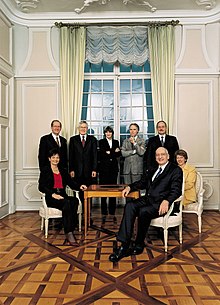
Switzerland was the last Western republic (the Principality of Liechtenstein followed in 1984) to grant women the right to vote. Some Swiss cantons approved this in 1959, while at the federal level, it was achieved in 1971[50][59][failed verification] and, after resistance, in the last canton Appenzell Innerrhoden (one of only two remaining Landsgemeinde, along with Glarus) in 1990. After obtaining suffrage at the federal level, women quickly rose in political significance. The first woman on the seven-member Federal Council executive was Elisabeth Kopp, who served from 1984 to 1989,[50] and the first female president was Ruth Dreifuss in 1999.[60]
In 1979 areas from the canton of Bern attained independence from the Bernese, forming the new canton of Jura. On 18 April 1999, the Swiss population and the cantons voted in favour of a completely revised federal constitution.[50]
In 2002 Switzerland became a full member of the United Nations, leaving Vatican City as the last widely recognised state without full UN membership. Switzerland is a founding member of the EFTA but not the European Economic Area (EEA). An application for membership in the European Union was sent in May 1992, but did not advance since rejecting the EEA in December 1992[50] when Switzerland conducted a referendum on the EEA. Several referendums on the EU issue ensued; due to opposition from the citizens, the membership application was withdrawn. Nonetheless, Swiss law is gradually changing to conform with that of the EU, and the government signed bilateral agreements with the European Union. Switzerland, together with Liechtenstein, has been surrounded by the EU since Austria's entry in 1995. On 5 June 2005, Swiss voters agreed by a 55% majority to join the Schengen treaty, a result that EU commentators regarded as a sign of support.[38] In September 2020, a referendum calling for a vote to end the pact that allowed a free movement of people from the European Union was introduced by the Swiss People's Party (SVP).[61] However, voters rejected the attempt to retake control of immigration, defeating the motion by a roughly 63%–37% margin.[62]
On 9 February 2014, 50.3% of Swiss voters approved a ballot initiative launched by the Swiss People's Party (SVP/UDC) to restrict immigration. This initiative was mostly backed by rural (57.6% approval) and suburban groups (51.2% approval), and isolated towns (51.3% approval) as well as by a strong majority (69.2% approval) in Ticino, while metropolitan centres (58.5% rejection) and the French-speaking part (58.5% rejection) rejected it.[63] In December 2016, a political compromise with the EU was attained that eliminated quotas on EU citizens, but still allowed favourable treatment of Swiss-based job applicants.[64] On 27 September 2020, 62% of Swiss voters rejected the anti-free movement referendum by SVP.[65]
Geography

Extending across the north and south side of the Alps in west-central Europe, Switzerland encompasses diverse landscapes and climates across its 41,285 square kilometres (15,940 sq mi).[66]
Switzerland lies between latitudes 45° and 48° N, and longitudes 5° and 11° E. It contains three basic topographical areas: the Swiss Alps to the south, the Swiss Plateau or Central Plateau, and the Jura mountains on the west. The Alps are a mountain range running across the central and south of the country, constituting about 60% of the country's area. The majority of the population live on the Swiss Plateau. The Swiss Alps host many glaciers, covering 1,063 square kilometres (410 sq mi). From these originate the headwaters of several major rivers, such as the Rhine, Inn, Ticino and Rhône, which flow in the four cardinal directions, spreading across Europe. The hydrographic network includes several of the largest bodies of fresh water in Central and Western Europe, among which are Lake Geneva (Lac Léman in French), Lake Constance (Bodensee in German) and Lake Maggiore. Switzerland has more than 1500 lakes and contains 6% of Europe's freshwater stock. Lakes and glaciers cover about 6% of the national territory. Lake Geneva is the largest lake and is shared with France. The Rhône is both the main source and outflow of Lake Geneva. Lake Constance is the second largest and, like Lake Geneva, an intermediate step by the Rhine at the border with Austria and Germany. While the Rhône flows into the Mediterranean Sea at the French Camargue region and the Rhine flows into the North Sea at Rotterdam, about 1,000 kilometres (620 miles) apart, both springs are only about 22 kilometres (14 miles) apart in the Swiss Alps.[66][67]
Forty-eight mountains are 4,000 metres (13,000 ft) or higher in height.[66] At 4,634 m (15,203 ft), Monte Rosa is the highest, although the Matterhorn (4,478 m or 14,692 ft) is the best known. Both are located within the Pennine Alps in the canton of Valais, on the border with Italy. The section of the Bernese Alps above the deep glacial Lauterbrunnen valley, containing 72 waterfalls, is well known for the Jungfrau (4,158 m or 13,642 ft) Eiger and Mönch peaks, and its many picturesque valleys. In the southeast the long Engadin Valley, encompassing St. Moritz, is also well known; the highest peak in the neighbouring Bernina Alps is Piz Bernina (4,049 m or 13,284 ft).[66]
The Swiss Plateau has greater open and hilly landscapes, partly forested, partly open pastures, usually with grazing herds or vegetable and fruit fields, but it is still hilly. Large lakes and the biggest Swiss cities are found there.[66]
Switzerland contains two small enclaves: Büsingen belongs to Germany, while Campione d'Italia belongs to Italy.[68] Switzerland has no exclaves.
Climate
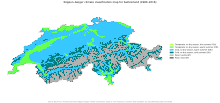
The Swiss climate is generally temperate, but can vary greatly across localities,[69] from glacial conditions on the mountaintops to the near-Mediterranean climate at Switzerland's southern tip. Some valley areas in the southern part of Switzerland offer cold-hardy palm trees. Summers tend to be warm and humid at times with periodic rainfall, ideal for pastures/grazing. The less humid winters in the mountains may see weeks-long intervals of stable conditions. At the same time, the lower lands tend to suffer from inversion during such periods, hiding the sun.[citation needed]
A weather phenomenon known as the föhn (with an identical effect to the chinook wind) can occur any time and is characterised by an unexpectedly warm wind, bringing low relative humidity air to the north of the Alps during rainfall periods on the south-facing slopes. This works both ways across the alps but is more efficient if blowing from the south due to the steeper step for oncoming wind. Valleys running south to north trigger the best effect. The driest conditions persist in all inner alpine valleys that receive less rain because arriving clouds lose a lot of their moisture content while crossing the mountains before reaching these areas. Large alpine areas such as Graubünden remain drier than pre-alpine areas, and as in the main valley of the Valais, wine grapes are grown there.[70]
The wettest conditions persist in the high Alps and in the Ticino canton, which has much sun yet heavy bursts of rain from time to time.[70] Precipitation tends to be spread moderately throughout the year, with a peak in summer. Autumn is the driest season, winter receives less precipitation than summer, yet the weather patterns in Switzerland are not in a stable climate system. They can vary from year to year with no strict and predictable periods.[citation needed]
Environment
Switzerland contains two terrestrial ecoregions: Western European broadleaf forests and Alps conifer and mixed forests.[71]
Switzerland's many small valleys separated by high mountains often host unique ecologies. The mountainous regions themselves offer a rich range of plants not found at other altitudes. The climatic, geological and topographical conditions of the alpine region make for a fragile ecosystem that is particularly sensitive to climate change.[69][72] According to the 2014 Environmental Performance Index, Switzerland ranks first among 132 nations in safeguarding the environment, due to its high scores on environmental public health, its heavy reliance on renewable sources of energy (hydropower and geothermal energy), and its level of greenhouse gas emissions.[73] In 2020 it was ranked third out of 180 countries.[74] The country pledged to cut GHG emissions by 50% by 2030 compared to the level of 1990 and plans to reach zero emissions by 2050.[75]
However, access to biocapacity in Switzerland is far lower than the world average. In 2016, Switzerland had 1.0 hectares[76] of biocapacity per person within its territory, 40 per cent less than world average of 1.6. In contrast, in 2016, Swiss consumption required 4.6 hectares of biocapacity – their ecological footprint, 4.6 times as much as Swiss territory can support. The remainder comes from other countries and the shared resources (such as the atmosphere impacted by greenhouse gas emissions).[76] Switzerland had a 2019 Forest Landscape Integrity Index mean score of 3.53/10, ranking it 150th globally out of 172 countries.[77]
Urbanisation
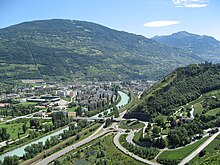
About 85% of the population live in urban areas.[78][79] Switzerland went from a largely rural country to an urban one from 1930 to 2000. After 1935 urban development claimed as much of the Swiss landscape as it did during the prior 2,000 years. Urban sprawl affects the plateau, the Jura and the Alpine foothills,[80] raising concerns about land use.[81] During the 21st century, population growth in urban areas is higher than in the countryside.[79]
Switzerland has a dense network of complementary large, medium and small towns.[79] The plateau is densely populated with about 400 people per km2 and the landscape shows uninterrupted signs of human presence.[82] The weight of the largest metropolitan areas – Zürich, Geneva–Lausanne, Basel and Bern – tend to increase.[79][clarification needed] The importance of these urban areas is greater than their population suggests.[79] These urban centers are recognised for their high quality of life.[83]
The average population density in 2019 was 215.2 inhabitants per square kilometre (557/sq mi).[84]: 79 In the largest canton by area, Graubünden, lying entirely in the Alps, population density falls to 28.0 inhabitants per square kilometre (73/sq mi).[84]: 30 In the canton of Zürich, with its large urban capital, the density is 926.8 per square kilometre (2,400/sq mi).[84]: 76
Government and politics

The Federal Constitution adopted in 1848 is the legal foundation of Switzerland's federal state.[85] A new Swiss Constitution was adopted in 1999 that did not introduce notable changes to the federal structure. It outlines rights of individuals and citizen participation in public affairs, divides the powers between the Confederation and the cantons and defines federal jurisdiction and authority. Three main bodies govern on the federal level:[86] the bicameral parliament (legislative), the Federal Council (executive) and the Federal Court (judicial).
Parliament
The Swiss Parliament consists of two houses: the Council of States which has 46 representatives (two from each canton and one from each half-canton) who are elected under a system determined by each canton, and the National Council, which consists of 200 members who are elected under a system of proportional representation, reflecting each canton's population. Members serve part-time for four years (a Milizsystem or citizen legislature).[87] When both houses are in joint session, they are known collectively as the Federal Assembly. Through referendums, citizens may challenge any law passed by parliament and, through initiatives, introduce amendments to the federal constitution, thus making Switzerland a direct democracy.[85]
Federal Council
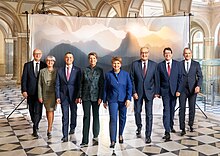
The Federal Council directs the federal government, the federal administration, and serves as a collective head of state. It is a collegial body of seven members, elected for a four-year term by the Federal Assembly, which also oversees the council. The President of the Confederation is elected by the Assembly from among the seven members, traditionally in rotation and for a one-year term; the President chairs the government and executes representative functions. The president is a primus inter pares with no additional powers and remains the head of a department within the administration.[85]
The government has been a coalition of the four major political parties since 1959, each party having a number of seats that roughly reflects its share of the electorate and representation in the federal parliament. The classic distribution of two CVP/PDC, two SPS/PSS, two FDP/PRD and one SVP/UDC as it stood from 1959 to 2003 was known as the "magic formula". Following the 2015 Federal Council elections, the seven seats in the Federal Council were distributed as follows:
- 1 seat for the Center Party (Die Mitte),[i]
- 2 seats for the Free Democratic Party (FDP/PRD),
- 2 seats for the Social Democratic Party (SPS/PSS),
- 2 seats for the Swiss People's Party (SVP/UDC).
Supreme Court
The function of the Federal Supreme Court is to hear appeals against rulings of cantonal or federal courts. The judges are elected by the Federal Assembly for six-year terms.[88]
Direct democracy

Direct democracy and federalism are hallmarks of the Swiss political system.[89] Swiss citizens are subject to three legal jurisdictions: the municipality, canton and federal levels. The 1848 and 1999 Swiss Constitutions define a system of direct democracy (sometimes called half-direct or representative direct democracy because it includes institutions of a representative democracy). The instruments of this system at the federal level, known as popular rights (German: Volksrechte, French: droits populaires, Italian: diritti popolari),[90] include the right to submit a federal initiative and a referendum, both of which may overturn parliamentary decisions.[85][91]
By calling a federal referendum, a group of citizens may challenge a law passed by parliament by gathering 50,000 signatures against the law within 100 days. If so, a national vote is scheduled where voters decide by a simple majority whether to accept or reject the law. Any eight cantons can also call a constitutional referendum on federal law.[85]
Similarly, the federal constitutional initiative allows citizens to put a constitutional amendment to a national vote, if 100,000 voters sign the proposed amendment within 18 months.[j] The Federal Council and the Federal Assembly can supplement the proposed amendment with a counterproposal. Then, voters must indicate a preference on the ballot if both proposals are accepted. Constitutional amendments, whether introduced by initiative or in parliament, must be accepted by a double majority of the national popular vote and the popular cantonal votes.[k][89]
Cantons
The Swiss Confederation consists of 26 cantons:[85][92]

|
| Canton | ID | Capital | Canton | ID | Capital | |||
|---|---|---|---|---|---|---|---|---|
| Aargau | 19 | Aarau | *Nidwalden | 7 | Stans | |||
| *Appenzell Ausserrhoden | 15 | Herisau | *Obwalden | 6 | Sarnen | |||
| *Appenzell Innerrhoden | 16 | Appenzell | Schaffhausen | 14 | Schaffhausen | |||
| *Basel-Landschaft | 13 | Liestal | Schwyz | 5 | Schwyz | |||
| *Basel-Stadt | 12 | Basel | Solothurn | 11 | Solothurn | |||
| Bern | 2 | Bern | St. Gallen | 17 | St. Gallen | |||
| Fribourg | 10 | Fribourg | Thurgau | 20 | Frauenfeld | |||
| Geneva | 25 | Geneva | Ticino | 21 | Bellinzona | |||
| Glarus | 8 | Glarus | Uri | 4 | Altdorf | |||
| Grisons | 18 | Chur | Valais | 23 | Sion | |||
| Jura | 26 | Delémont | Vaud | 22 | Lausanne | |||
| Lucerne | 3 | Lucerne | Zug | 9 | Zug | |||
| Neuchâtel | 24 | Neuchâtel | Zürich | 1 | Zürich | |||
*These cantons are known as half-cantons.
The cantons are federated states. They have a permanent constitutional status and, in comparison with other countries, a high degree of independence. Under the Federal Constitution, all 26 cantons are equal in status, except that 6 (referred to often as the half-cantons) are represented by one councillor instead of two in the Council of States and have only half a cantonal vote with respect to the required cantonal majority in referendums on constitutional amendments. Each canton has its own constitution and its own parliament, government, police and courts.[92] However, considerable differences define the individual cantons, particularly in terms of population and geographical area. Their populations vary between 16,003 (Appenzell Innerrhoden) and 1,487,969 (Zürich), and their area between 37 km2 (14 sq mi) (Basel-Stadt) and 7,105 km2 (2,743 sq mi) (Grisons).
Municipalities
As of 2018 the cantons comprised 2,222 municipalities.
Federal City
Until 1848, the loosely coupled Confederation did not have a central political organisation. Issues thought to affect the whole Confederation were the subject of periodic meetings in various locations.[93]
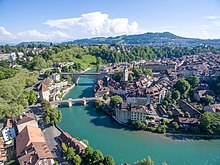
In 1848, the federal constitution provided that details concerning federal institutions, such as their locations, should be addressed by the Federal Assembly (BV 1848 Art. 108). Thus on 28 November 1848, the Federal Assembly voted in the majority to locate the seat of government in Bern and, as a prototypical federal compromise, to assign other federal institutions, such as the Federal Polytechnical School (1854, the later ETH) to Zürich, and other institutions to Lucerne, such as the later SUVA (1912) and the Federal Insurance Court (1917).[1] Other federal institutions were subsequently attributed to Lausanne (Federal Supreme Court in 1872, and EPFL in 1969), Bellinzona (Federal Criminal Court, 2004), and St. Gallen (Federal Administrative Court and Federal Patent Court, 2012).
The 1999 Constitution does not mention a Federal City and the Federal Council has yet to address the matter.[94] Thus no city in Switzerland has the official status either of capital or of Federal City. Nevertheless, Bern is commonly referred to as "Federal City" (German: Bundesstadt, French: ville fédérale, Italian: città federale).
Foreign relations and international institutions
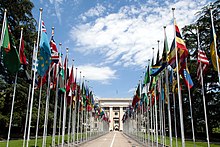
Traditionally, Switzerland avoids alliances that might entail military, political, or direct economic action and has been neutral since the end of its expansion in 1515. Its policy of neutrality was internationally recognised at the Congress of Vienna in 1815.[95][96] Swiss neutrality has been questioned at times.[97][98] In 2002 Switzerland became a full member of the United Nations.[95] It was the first state to join it by referendum. Switzerland maintains diplomatic relations with almost all countries and historically has served as an intermediary between other states.[95] Switzerland is not a member of the European Union; the Swiss people have consistently rejected membership since the early 1990s.[95] However, Switzerland does participate in the Schengen Area.[99]
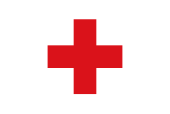
Many international institutions have headquarters in Switzerland, in part because of its policy of neutrality. Geneva is the birthplace of the Red Cross and Red Crescent Movement, the Geneva Conventions and, since 2006, hosts the United Nations Human Rights Council. Even though Switzerland is one of the most recent countries to join the United Nations, the Palace of Nations in Geneva is the second biggest centre for the United Nations after the headquarters in New York. Switzerland was a founding member and hosted the League of Nations.[48]
Apart from the United Nations headquarters, the Swiss Confederation is host to many UN agencies, including the World Health Organization (WHO), the International Labour Organization (ILO), the International Telecommunication Union (ITU), the United Nations High Commissioner for Refugees (UNHCR) and about 200 other international organisations, including the World Trade Organization and the World Intellectual Property Organization.[95] The annual meetings of the World Economic Forum in Davos bring together business and political leaders from Switzerland and foreign countries to discuss important issues. The headquarters of the Bank for International Settlements (BIS) moved to Basel in 1930.[citation needed]
Many sports federations and organisations are located in the country, including the International Handball Federation in Basel, the International Basketball Federation in Geneva, the Union of European Football Associations (UEFA) in Nyon, the International Federation of Association Football (FIFA) and the International Ice Hockey Federation both in Zürich, the International Cycling Union in Aigle, and the International Olympic Committee in Lausanne.[101]
Switzerland is scheduled to become a member of the United Nations Security Council for the 2023–2024 period.[102]
Switzerland and the European Union
Although not a member, Switzerland maintains relationships with the EU and European countries through bilateral agreements. The Swiss have brought their economic practices largely into conformity with those of the EU, in an effort to compete internationally. EU membership faces considerable negative popular sentiment. It is opposed by the conservative SVP party, the largest party in the National Council, and not advocated by several other political parties. The membership application was formally withdrawn in 2016. The western French-speaking areas and the urban regions of the rest of the country tend to be more pro-EU, but do not form a significant share of the population.[103][104]
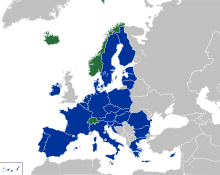
An Integration Office operates under the Department of Foreign Affairs and the Department of Economic Affairs. Seven bilateral agreements liberalised trade ties, taking effect in 2001. This first series of bilateral agreements included the free movement of persons. A second series of agreements covering nine areas was signed in 2004, including the Schengen Treaty and the Dublin Convention.[105]
In 2006, a referendum approved 1 billion francs of supportive investment in Southern and Central European countries in support of positive ties to the EU as a whole. A further referendum will be needed to approve 300 million francs to support Romania and Bulgaria and their recent admission.
The Swiss have faced EU and international pressure to reduce banking secrecy and raise tax rates to parity with the EU. Preparatory discussions involved four areas: the electricity market, participation in project Galileo, cooperating with the European Centre for Disease Prevention and Control and certificates of origin for food products.[106][needs update]
Switzerland is a member of the Schengen passport-free zone. Land border checkpoints apply on to goods movements, but not people.[107]
Military
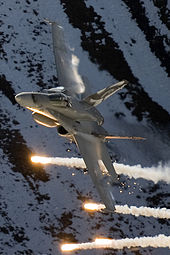
The Swiss Armed Forces, including the Land Forces and the Air Force, are composed mostly of conscripts, male citizens aged from 20 to 34 (in exceptional cases up to 50) years. Being a landlocked country, Switzerland has no navy; however, on lakes bordering neighbouring countries, armed boats patrol. Swiss citizens are prohibited from serving in foreign armies, except for the Swiss Guards of the Vatican, or if they are dual citizens of a foreign country and reside there.[citation needed]
The Swiss militia system stipulates that soldiers keep their army-issued equipment, including fully automatic personal weapons, at home.[108] Women can serve voluntarily. Men usually receive military conscription orders for training at the age of 18.[109] About two-thirds of young Swiss are found suitable for service; for the others, various forms of alternative service are available.[110] Annually, approximately 20,000 persons are trained in recruit centres for 18 to 21 weeks. The reform "Army XXI" was adopted by popular vote in 2003, replacing "Army 95", reducing the rolls from 400,000 to about 200,000. Of those, 120,000 are active in periodic Army training, and 80,000 are non-training reserves.[111]
Zdroj:https://en.wikipedia.org?pojem=Switzerland
Text je dostupný za podmienok Creative Commons Attribution/Share-Alike License 3.0 Unported; prípadne za ďalších podmienok. Podrobnejšie informácie nájdete na stránke Podmienky použitia.
Antropológia
Aplikované vedy
Bibliometria
Dejiny vedy
Encyklopédie
Filozofia vedy
Forenzné vedy
Humanitné vedy
Knižničná veda
Kryogenika
Kryptológia
Kulturológia
Literárna veda
Medzidisciplinárne oblasti
Metódy kvantitatívnej analýzy
Metavedy
Metodika
Text je dostupný za podmienok Creative
Commons Attribution/Share-Alike License 3.0 Unported; prípadne za ďalších
podmienok.
Podrobnejšie informácie nájdete na stránke Podmienky
použitia.
www.astronomia.sk | www.biologia.sk | www.botanika.sk | www.dejiny.sk | www.economy.sk | www.elektrotechnika.sk | www.estetika.sk | www.farmakologia.sk | www.filozofia.sk | Fyzika | www.futurologia.sk | www.genetika.sk | www.chemia.sk | www.lingvistika.sk | www.politologia.sk | www.psychologia.sk | www.sexuologia.sk | www.sociologia.sk | www.veda.sk I www.zoologia.sk




